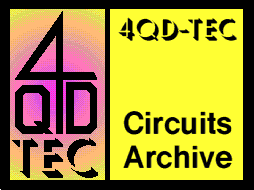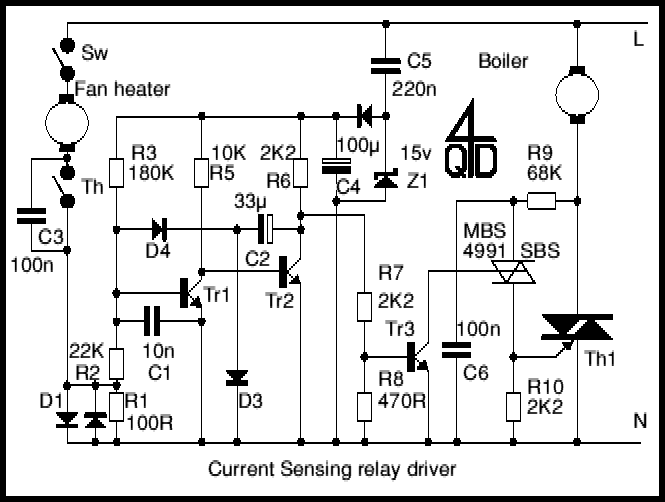

|
4QD-TEC
|
|
Almost all electronic circuits, unless they are Hall effect, actually sense voltage - not current. So to convert the current you want to sense to a suitable voltage you use a current-to-voltage converter. No, that's not an expensive chip! They're usually known as resistors! In this one the sensing resistor is bypassed by diodes (so the current sensed can be varied over a wide range.
The current to be sensed should flow from A to B. It flows either through R1 or (if big enough) through D1. There is an anti-parallel diode also present so the circuit can be used equally well for d.c. or a.c. sensing.
With the relay off, Tr1 is not conducting so Tr2 must be. Therefore Tr1 must be off. This occurs (surprise!) at zero current. The 12v supply line will cause current to flow through R3 and R2 so a voltage {12x(R2+R1)/(R1+R2+R3)} will be developed on the base of Tr1. This voltage is 390 millivolts - enough to bring Tr1 near to turn on. Any voltage developed across R1 will add to this 390mV.
When the turn-on voltage gets to about 550mV, Tr1 will turn on, so only 160mV is needed across R1, or around 160 micro-amps through it. Obviously you can alter R1 or even R3 to reduce or increase this but do remember that transistor base-emiter voltage reduces abour 2 millivolt for every degree centigrade temperature rise. Make the circuit too sensitive and it will turn on if the weather gets too warm!

Tr1 turning on causes Tr2 to turn off so Tr2's collector goes high. C2 now charges up via D4 and R4, keeping Tr1 turned on during charging (about 300mSec with these values). If the input is a.c. then, after this charging period, Tr1 will turn off at the next zero-crossing interval, so Tr2's collector will go low again, discharging C2 quickly (about 3mSec) via D3. This 'pumped feedback' technique is quite effective. Although the circuit does turn off, this so brief that the negative dips can be smoothed out easily - that is the function of C3.
The next circuit is a practical application of the current sensor. It was used in the centeal hearing control system of an old house I 'did up'. Now the walls were thin and poor insulators. Rather than keep the heat on permanently we had fan assisted heaters in each room which were switched on as required. These heaters have a thermostat in them which switches off the fan until the water is hot. So you need to be a bit crafty to sense the difference in current between a fan heater which is switched off and one which is on but not fanning because it is cold!
Before I go any further - a word of warning. The following circuit is directly connected to the mains. It is threrefore potentially extremely dangerous if you are not familiar with operation on live circuits. You use the circuit entirely at your own risk and claims from next-of-kin will not be accepted!

Sw is the on/off switch in the fan heater. Th is the fan heater's thermostat which stops it fanning when the water is cold. Note C3 - a 100n capacitor across the thermostat. This has no affect on the fan but does alow enough leakage current to flow (when Sw is closed) to operate the current detector.
The more astute amongst you may notice that D3 and D4 are reversed (compared with the first circuit). To explain this I shall start at the output. For the triac to be turned on, the SBS must conduct. It will ony do this if Tr3 is conducting. (If you don't know about the SBS - you missed the explanation on the first page off circuits!) So Tr2 must be turned on and Tr1 off. For the output to be on when the input is off is reversed logic from the first circuit. This one is biased with Tr1 normally on, the negative voltage developed across D2 turns Tr1 off and he pump holds Tr1 off.
I don't know if you can still get SBS devices. They were made by Motorola, MBS 4991 and 4992, but it's probably easier to use the 4 transistor circuit.
The other thing I should cover is the power supply.. it's a little unusual. Firstly I used a capacitor as a dropper, rather than a resistor. Capacitors don't dissipate heat. You must use a class X2 capacitor: these are designed for safe operation when connected directly across the mains. The 100n across the thermostat must also be X2 class.
The capacitor feeds directly to the zener diode: this is an unusual use of a zener since the current through it will be alternating! In one direction (the one we don't want) it will simply conduct as a forward-biased diode, but on the other half-cycle it will develop 15v across it. This 15v feeds through the second diode to charge up the 100µ reservoir capacitor (C4).
| 4QD Sites: |